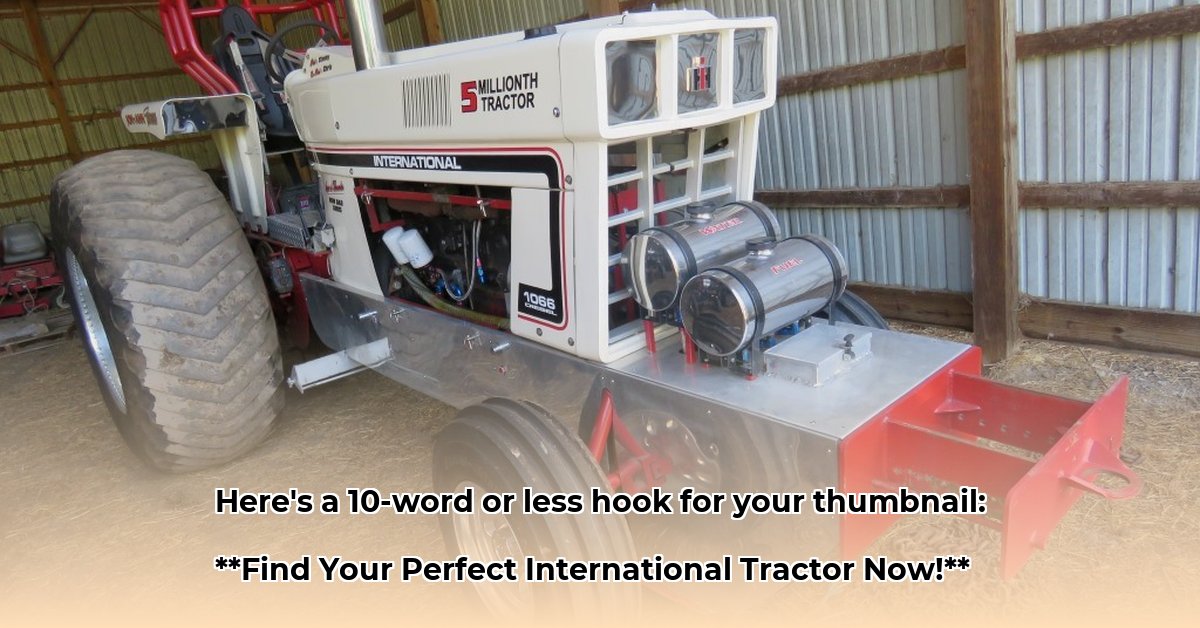
International Pulling Tractors: A Buyer's Guide to Powerhouse Machines
The world of competitive tractor pulling demands specialized equipment, and International Harvester tractors are legendary in this arena. Their robust design, coupled with the availability of performance-enhancing upgrades, makes them highly sought after. However, purchasing a used International pulling tractor requires careful consideration. This guide will walk you through identifying desirable models, verifying part quality, and navigating the market to find the perfect machine for your needs. For more International tractor resources, check out this helpful site: International Tractor Info.
Top Models for the Pulling Field: Legends of the Track
Certain International models stand out as favorites among competitive pullers. Their power, reliability, and potential for modification make them highly desirable. Let's explore some top contenders:
1. International 1066:
[Insert Image Here]
- Key Features: Powerful Riverside engine (a common and highly desirable feature), sturdy manual transmission. Known for its reliability and readily available parts.
- Typical Condition: Condition varies widely. Look for well-maintained examples with documented maintenance history.
- Typical Price Range: $30,000 - $50,000+ (depending on condition and modifications).
2. International 1466:
[Insert Image Here]
- Key Features: Often features upgraded transmissions and higher horsepower. A true powerhouse.
- Typical Condition: Higher prices reflect well-maintained examples; major repairs can be costly.
- Typical Price Range: $40,000 - $65,000+ (and potentially higher).
3. International 460:
[Insert Image Here]
- Key Features: Smaller, nimble, and potentially more affordable entry point. Often heavily modified for competitive pulling.
- Typical Condition: Condition varies significantly. Thorough inspection of modifications is crucial.
- Typical Price Range: $25,000 - $40,000 (can fluctuate considerably).
4. International 86 Series:
[Insert Image Here]
- Key Features: Durable and adaptable to various pulling modifications; suitable for experienced and novice pullers.
- Typical Condition: Age and potential modification history necessitate a thorough inspection.
- Typical Price Range: Highly variable, based on condition, upgrades, and location.
High-quality images are essential; request additional photos and videos if needed. A detailed picture paints a thousand words (and horsepower!)
Buying Used: A Step-by-Step Guide to Success
Purchasing a used pulling tractor is a substantial investment. Follow these steps to ensure a smooth and successful transaction:
1. Pre-Purchase Inspection: A hands-on examination is crucial. Check the engine for leaks and corrosion, ensure smooth shifting in the transmission, inspect hydraulics for leaks and unusual sounds, and thoroughly assess the overall condition, noting rust, dents, and wear and tear.
2. Test Drive: Perform a thorough test drive, paying close attention to power delivery, handling, and any unusual noises. A pulling-related test, if possible, is invaluable.
3. Mechanic's Inspection: Investing in a pre-purchase inspection from a mechanic familiar with pulling tractors is highly recommended. This can prevent costly surprises later.
4. Price Negotiation: Research comparable tractors to determine a fair market value. Be prepared to negotiate, but ensure you're working within a reasonable price range.
5. Paperwork Review: Carefully examine all paperwork, including the title and maintenance records. Complete documentation is essential. Incomplete or missing paperwork warrants caution.
High-Demand Parts: Performance and Price Considerations
The performance of a pulling tractor hinges on its key components. The demand for high-quality parts directly impacts cost.
- Riverside Engines: Highly sought after for their power and reliability. Expect premium pricing.
- Atlas Transmissions: Known for durability and high-torque handling. A well-maintained Atlas transmission is a valuable asset.
- Harts Turbos: Essential for maximizing engine power. Verify condition and functionality meticulously.
Remember to factor in the considerable shipping costs for these large components.
Market Overview: Regional Trends and Pricing
Prices for used pulling tractors vary significantly based on location and condition. Areas with frequent pulling events typically command higher prices.
Regional Price Trends (General):
- Midwest US: Generally higher prices due to the concentration of pulling events.
- Southern US: More variable pricing, reflecting event frequency and competitive intensity.
- Western US: Moderate to high prices, contingent on regional event schedules and market dynamics.
Resources for Your Search
Several tools can assist in finding your next pulling tractor:
- Online Forums: Platforms like pulloff.com (https://pulloff.com/) and others provide valuable information and connections within the pulling community.
- Auction Sites: Online auction sites often feature used pulling tractors.
- Specialized Publications: Publications catering to agricultural machinery can list tractors for sale.
Risk Assessment of Critical Components
Even well-maintained tractors can experience part failures. Consider the following:
| Component | Potential Risks | Mitigation Strategies |
|---|---|---|
| Riverside Engine | Major overhaul or replacement due to age/wear. | Regular maintenance, thorough pre-purchase check. |
| Atlas Transmission | Internal failure, requiring costly repair. | Pre-purchase inspection, confirming proper function. |
| Harts Turbocharger | Loss of power, potential engine damage. | Thorough inspection, ensuring proper sizing and condition. |
| Custom Modifications | Wide range of potential issues; difficult to assess. | Extreme caution. Verify quality and craftsmanship. |
Buying a used pulling tractor requires careful planning and due diligence. Remember to meticulously inspect, negotiate fairly, verify part quality, and leverage available resources. Good luck with your search!